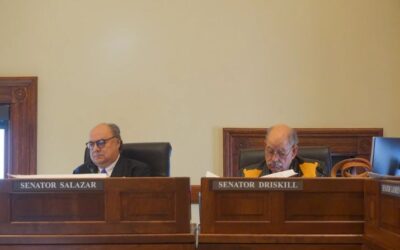Make our newscast part of your daily listening routine. Subscribe on Spotify (or wherever you listen to podcasts).
It’s late September in the Tetons, too early for snowfall on the peaks to make it to the valley floor — meaning it’s still warm enough for recreators near the river like Orion Hatch.
He dropped his raft from a trailer for an afternoon float from Moose to Wilson.
“The eagle has landed,” Hatch said.
The executive director of the Snake River Fund, a river advocacy group, pushed through the shimmering yellows and dots of green from aspens lining the banks. This stretch of the Snake River slithers through some of the most coveted and expensive properties in the nation, north of Jackson.

Orion Hatch, the executive director of the Snake River Fund, begins a float at the Moose Landing boat launch inside Grand Teton National Park. (Dante Filpula Ankney / KHOL)
Hatch is headed to three of about 20 different parcels of land he and others have been working to transfer from the Bureau of Land Management to Teton County. The deal is considered by many to be a slam dunk. But over nearly a quarter century, it’s been stuck in bureaucratic processes and political negotiations.
He hopes the transfer would protect the public land for the long run and allow it to be managed for multiple uses including wildlife habitat, open space, public access and public recreation.
“We want to ensure that the public has reasonable access to their public lands in perpetuity,” Hatch said.
Today the smattering of parcels along the Snake River are still available for public use, but they’re not often talked about, Hatch said.
They’re “forgotten gems,” he said.
Despite slow progress and existing access, it’s not time to give up, said Teton County Commission Chair Luther Propst.
“Hey, these lands are already BLM, why worry? The worry is that we’re trying to head off a problem into the future,” Propst said.
Propst, like Hatch, worries that if the land is not protected now, it could end up in private hands.
“In the end, we don’t want to be caught with our pants down when somebody comes along and makes a big offer and could privatize it during an administration that might not be friendly to the conservation value of these lands,” Propst said.

Wildlife tracks on one of the about 20 BLM parcels. Hatch says the parcels should be managed for multiple uses including wildlife habitat. (Dante Filpula Ankney / KHOL)
The forgotten gems are an invention of relatively recent engineering.
In the mid-20th century, the Army Corps of Engineers constructed a levee system on the Snake River. The walls cut off the river’s natural channels — significantly shrinking its size and drying up swaths of previously unusable land beneath the Tetons.
“So where once the Snake River was over a mile wide, it today is anywhere between 1000 and 1400 feet wide,” Hatch said.
Some of that land went to private landowners and some stuck with the Federal Government, managed by the BLM.
Fast forward to the turn of the century — the BLM made it known that the parcels under their current ownership are too remote for the agency, with the nearest office a two hours drive in Pinedale. So Teton County, in partnership with a variety of local non-governmental organizations like the Snake River Fund working as facilitators, jumped on the opportunity to manage the land locally.
“But unfortunately, you know, it’s a slow process in coming to agreements that make everybody happy,” Hatch said. “It’s more difficult than I think anybody anticipated.”
Today, advocacy groups, consultants, county electeds and government staff are still pushing for the land transfer — churning out report after report, negotiating plan after plan for review.

The Snake River Fund is one of several local groups in town working with the county to see the land transfer through. (Dante Filpula Ankney / KHOL News)
There are two different ways the transfer could happen, Hatch said.
The first is via a federal law called the Recreation and Public Purposes Act which would allow the feds to sell or lease the land to the county if it can show how it would follow federal management guidelines.
“Some of the parcels have been moved closer to transfer than they ever have been in the past,” Hatch said, “right through that application process.”
Three of the parcels, which include land near the Wilson and South Park Boat Ramps, were proposed to the Pinedale BLM office for an environmental review and were approved. The BLM said they are finalizing that review internally but there are still many steps to go.
The second route — which would apply to the large majority of parcels — is an act of Congress. Hatch said Wyoming Senator John Barasso has signified interest in introducing a bill but not without strings attached.
He said Barasso would like all parcels included in the legislation and all neighboring landowners to be on board. Senator Barrasso did not respond to a request for comment for this story.
“We want to get all of these parcels tied up with a nice, neat little bow and ready to be presented to the legislature,” Hatch said.
But according to Hatch, there’s one landowner bordering one parcel that’s holding up the process, the Walton Ranch.
“That parcel has been embroiled in conflict with the adjacent landowner who has presented terms to the Teton County that ultimately include limiting some of the public access to those parcels,” Hatch said.
Hatch said limiting public access doesn’t align with the Snake River Fund’s mission. KHOL did not hear back from the landowner’s attorney.
At the end of the three-hour float, Hatch dropped the oars and hopped out of his raft and onto the embankment. He walked south along the gravel Snake River Trail, alongside the land where he and others are waiting for an agreement with the Walton Ranch landowner. It’s a popular spot for everyone from dog walkers to runners and bikers.

If the land transfer is finalized, Hatch imagines working with Teton County to offer programs and promote access to the public parcels like Parcel #6 where a picnic table and small fireplace are obscured from river users by aspen. (Dante Filpula Ankney / KHOL)
He pointed at barbed wire where he’d like to see ramps for clear public access and at mature cottonwoods he imagines meandering trails. There is still hope, he said, for the landowner to maintain their land rights and for the public to more easily access land that’s already theirs.
County commissioner Propst said the transfer is still a high priority but is unsure when the deal may be finalized.
“I have no idea,” Propst said. “I’m an eternal optimist. I’d like to see it done, but it’s a couple of years out, no matter what.”






